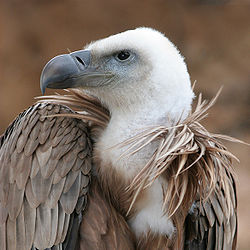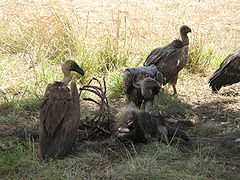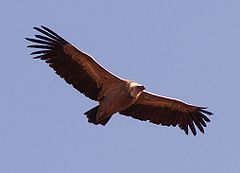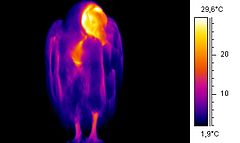
Vulture
Background Information
SOS Children volunteers helped choose articles and made other curriculum material Click here for more information on SOS Children.
| Vultures | |
|---|---|
 |
|
| Griffon vulture, Gyps fulvus | |
| Scientific classification | |
| Kingdom: | Animalia |
| Phylum: | Chordata |
| Class: | Aves |
| Orders | |
|
Falconiformes (Fam. Accipitridae (part)) |
|
Vultures are scavenging birds, feeding mostly on the carcasses of dead animals. Vultures are found on every continent except Antarctica and Oceania.
A particular characteristic of many vultures is a bald head, devoid of feathers. This is likely because a feathered head would become spattered with blood and other fluids, and thus be difficult to keep clean.
A group of vultures is occasionally called a venue, and when circling in the air a group of vultures is called a kettle. The word Geier (taken from the German language) does not have a precise meaning in ornithology, and it is occasionally used to refer to a vulture in English, as in some poetry.
Classification
Vultures are classified into two groups: Old World vultures and New World vultures. The similarities between the two different groups are due to convergent evolution.
Old World vultures
The Old World vultures found in Africa, Asia, and Europe belong to the family Accipitridae, which also includes eagles, kites, buzzards, and hawks. Old World vultures find carcasses exclusively by sight.
New World vultures
The New World vultures and condors found in warm and temperate areas of the Americas are not closely related to the superficially similar Accipitridae, but belong in the family Cathartidae, which is quite close to the storks. Several species have a good sense of smell, unusual for raptors, and are able to smell the dead they focus upon from great heights.
Feeding

Vultures seldom attack healthy animals, but may kill the wounded or sick. Vast numbers have been seen upon battlefields. They gorge themselves when prey is abundant, till their crop bulges, and sit, sleepy or half torpid, to digest their food. They do not carry food to their young in their claws, but disgorge it from the crop. These birds are of great value as scavengers, especially in hot regions. Botulinum toxin, the toxin that causes botulism, does not affect them, and they can eat rotten flesh containing anthrax and cholera bacteria. When a vulture's dinner has too thick of hide for his beak to open, he waits for a larger scavenger to eat first.
Threat due to diclofenac poisoning
Diclofenac poisoning has caused the vulture population in India and Pakistan to decline by up to 95% in the past decade, and two or three of the species of vulture in South Asia are nearing extinction. This has been caused by the practice of medicating working farm animals with diclofenac, which is a non-steroidal anti-inflammatory drug ( NSAID) with anti-inflammatory and pain killing actions. Diclofenac administration keeps animals that are ill or in pain working on the land for longer, but, if the ill animals die, their carcasses contain diclofenac. Farmers leave the dead animals out in the open, relying on vultures to tidy up. Diclofenac present in carcass flesh is eaten by vultures, which are sensitive to diclofenac, and they suffer kidney failure, visceral gout, and death as a result of diclofenac poisoning.
The decline in vultures has led to hygiene problems in India as carcasses of dead animals now tend to rot, or be eaten by rats or wild dogs, rather than be tidied up by vultures. Rabies among these other scavengers is a major health threat. India has one of the world's highest incidences of rabies.
The decline in vultures causes particular problems for certain communities, such as the Parsi, who practice sky burials, where the human dead are put on the top of Towers of Silence and are eaten by vultures, leaving only dry bones.
Meloxicam (another NSAID) has been found to be harmless to vultures and should prove an acceptable alternative to diclofenac. The Government of India banned diclofenac, but over a year later, in 2007, it continued to be sold and is still a problem in other parts of the world.
In culture
Ancient Egypt
In Southern Africa, the name for a Nubian vulture is synonymous with the term applied to lovers, because these vultures are always seen in pairs, mother and child remaining closely bonded together. Pairing, bonding, protecting, and loving are essential attributes associated along with the vulture's size and its ability to soar high in the sky.
The Egyptians considered the vulture to be an excellent mother, and the wide wingspan was seen as all-encompassing and providing a protective cover to her infants. The white Egyptian vulture was the animal picked to represent Nekhbet, the mother goddess and protective patron of southern, Upper Egypt. The vulture hieroglyph
|
was the uniliteral sign used for the glottal sound (3) including words such as mother, prosperous, grandmother, and ruler
Contemporary concepts
Although the vulture plays an important natural role, in the Western world, the image of the vulture is quite negative, with 'vulture' used as a metaphor for those who prey on the weak or dying, with associated negative connotations of cowardice and selfishness.





